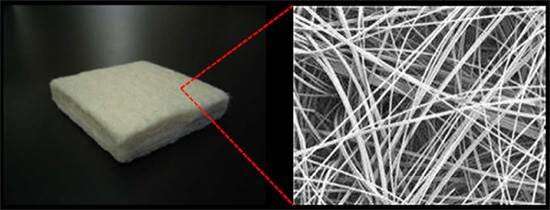Spacer protects healthy organs from radiation exposure during particle therapy

Kobe University and Alfresa Pharma Corporation have developed a novel medical device with a non-woven fabric style made of bioabsorbable material.
It can be difficult to treat malignant tumors using radical particle therapy if the tumor is too close to healthy organs. A team led by Professor Takumi Fukumoto and Professor Ryohei Sasaki (Kobe University Graduate School of Medicine) has collaborated with Alfresa Pharma Corporation to develop a new medical device, "Neskeep," to separate tumors from adjacent normal organs during particle therapy. Neskeep is designed to be placed in a surgical procedure.
Neskeep received pharmaceutical approval in December 2018 and is available for purchase after June 27, 2019.
Radiation therapy, one of the less invasive and less stressful treatments, has been recognized as an important cancer treatment. Health insurance from the Japanese government covers particle therapies for bone and soft tissue tumors, pediatric malignant tumors, and non-squamous head and neck tumors.
In some cases, it can be difficult to apply particle therapy when malignant tumors are located near digestive tract organs sensitive to radiation (the small and large intestine). Doctors currently use non-absorbent materials such as silicone balloons and Gore-Tex sheets to act as spacers in the abdomen and intestines, or they place the intestine or other organs outside the radiation field using an absorbent mesh. Based on several observations, some patients may then undergo a second surgery to remove the spacer or it may cause serious complications in their bodies for the rest of their lives.
The team succeeded in developing a nonwoven fabric bioabsorbable spacer that can create a space between healthy and cancerous tissues during particle therapy. After that, the spacer is safely absorbed by the body.
Neskeep is available in 5, 10 and 15mm nonwoven fabrics using polyglycolic acid, the same material as polyglycolic acid suture thread (Opepolix N (approval code: 16200BZZ01566000) and Opepolix (approval code: 16200BZZ01566000), both already approved for medical use.
In their preclinical evaluation, the team conducted physical experiments to check that the spacer fulfilled the requirements for isolating cancer from organs and providing a barrier against radiation. After safety studies in animal models, a clinical trial was carried out in Kobe University Hospital and Hyogo Ion Beam Medical Center (HIBMC). The human trial involved five patients with malignant tumors in the abdominal or pelvic region, for whom particle therapy was difficult because of the proximity of normal organs to the cancer.
In all treatments the spacer preserved enough distance between the tumor and healthy tissue during the particle therapy. Having successfully reduced the radiation exposure to the intestines, they were able to use a full dose of radiation therapy. There were no serious complications observed with this treatment, and they confirmed that the spacers safely disintegrated afterwards.
Particle therapy to treat malignant tumors is a promising new radiation treatment, and it is available in a growing number of clinics. Initially this spacer will be used mainly to treat bone tumors that are covered by insurance for particle therapy treatment. The team hopes to expand the use of this spacer alongside the expansion of insurance coverage for particle therapy, ultimately using it to treat conditions such as pancreatic and liver cancers.
More information: Ryohei Sasaki et al. First-In-Human Phase 1 Study of a Nonwoven Fabric Bioabsorbable Spacer for Particle Therapy: Space-Making Particle Therapy (SMPT), Advances in Radiation Oncology (2019). DOI: 10.1016/j.adro.2019.05.002
Hiroaki Akasaka et al. Preclinical Evaluation of Bioabsorbable Polyglycolic Acid Spacer for Particle Therapy, International Journal of Radiation Oncology* Biology* Physics (2014). DOI: 10.1016/j.ijrobp.2014.07.048














